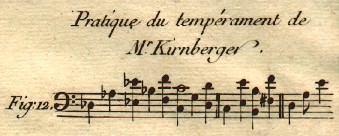Technical Library
TEMPERAMENTS V: Kirnberger II
Entire Contents Copyright © 2020 CBHTechnical LibraryTEMPERAMENTS V: Kirnberger II Entire Contents Copyright © 2020 CBH |
 CAREY BEEBE |
| Late eighteenth-century French tuning instructions |
By shuffling the two half wolves of Grammateus to different locations around our circle of keys, we approach a temperament by Johann Philipp Kirnberger (1721–1783) from his 1771 Die Kunst des reinen Satzes in der Musik. Note this is not the usual temperament that musicians today mean when they refer to “Kirnberger”—for that, you should look on the following page for the instructions for tuning Kirnberger III, one of the best temperaments for first-time tuners to gain confidence with.
Let’s call this simple temperament Kirnberger II. Kirnberger’s work was disseminated widely at the time. Study the late eighteenth-century French notation in the figure at the left, comparing it to the diagram in our usual style below.
 Kirnberger worked his temperament from a D♭—a pitch for which few musicians would own a tuning fork today. Here’s a method you can use to set Kirnberger II on your instrument, beginning on a more friendly C:
Kirnberger worked his temperament from a D♭—a pitch for which few musicians would own a tuning fork today. Here’s a method you can use to set Kirnberger II on your instrument, beginning on a more friendly C:
1. Tune your c'' (that’s the c one octave above middle c'!) to a tuning fork or other pitch source, and tune middle c' and tenor c in absolute perfect tune below it.
2. Tune all the fifths from the flat side of C around the circle of keys absolutely pure, stopping at the D♭.
3. Tune your g a pure fifth above tenor c, and then d' a pure fifth above g. Tune down an octave to d.
4. Now we want to determine the e' a pure third above middle c': This will be a revelation if you have never heard a pure third before. Your violinist friends are going to find it unbearably flat, but we want it in perfect tune. (Hint: If you split your interval over the octave, you will find it easier to hear because the speed of the beats is halved, so play the interval tenor c to e'.) Tune down an octave from e' to e.
5. There are two pure fifths to determine around the sharp side of E. Tune up a pure fifth from your e to b and again from b to f♯'. (Don’t worry that our eighteenth-century engraver has omitted a sharp sign from the top f♯' in his Practique.) You’ve placed these notes correctly if your b also makes a pure third up from g, and your f♯' likewise a pure third above d'.
6. The final and hardest part in this temperament is to locate your A midway between D and E. The tenor a is represented as a quaver (halfnote) in the final bar of the original notation, fitted between d and e'. From our circular representation, you can see that Kirnberger has split the comma into two, giving you two very narrow half-comma fifths. Tune your a a pure fifth above d, and then flatten the a until the interval d–a sounds almost as rough as a–e'. If you’ve just tuned Grammateus, you have an idea what a half-wolf sounds like.
Now you can play some music and see what you have wrought, verifying with your ears what you can see on the circular diagram. This temperament is characterized by absolutely in tune C Major and G Major triads. Not only the fifths, but also the Major thirds of these keys are in absolute tune, with complete absence of beats. You also have a perfectly in tune third above D. All the pure thirds are shown by the connecting lines in the diagram.
In theory, your error or schisma is located between F♯ and D♭ in the circle of keys—look for the “±0”—and is in fact an equal-tempered fifth in size. In practice, though, you may find that all your fifths around the flat side of C as far as E end up sounding pretty much pure.
Again, when you are happy with your middle octave, you must bring the rest of your instrument into tune with what you have done. Tune down in octaves, and up in octaves, then tune the other choirs in tune with your first register by proceeding from bass to treble, checking as you go. The four pure thirds (f–a, c'–e', g–b & d'–f♯') should not only be pure in the middle of the keyboard, but should also be perfect everywhere else.
Writers on temperaments—then and now—face criticism, and poor Kirnberger copped some flak for his half-comma fifths. Fortunately, he set to work and later published a correction which is now his better-known temperament, and the one I recommend beginning tuners learn first.
Further discussion
Anonymous [Kayano, Moxzan] Dodecagon — Chi-s akt temo Tokyo 2012, p16
Asselin, Pierre-Yves Musique et Tempérament Éditions Costallat, Paris 1985, p90
Barbour, J Murray Tuning and Temperament Michigan State College Press, East Lansing 1951, p158
Jorgensen, Owen The Equal-beating Temperaments The Sunbury Press, Raleigh 1981, p23 (“Johann Philipp Kirnberger Well-Temperament in C Major”)
Klop, G C Harpsichord Tuning Werkplaats voor Clavecimbelbouw, Garderen 1974, p22
Padgham, Charles The Well-Tempered Organ Positive Press, Oxford 1986, p64
| Pitch nomenclature | |
| Harpsichord Tuning Process | |
| Tuning Bibliography | |
| Technical Library overview | |
| Harpsichords Australia Home Page |